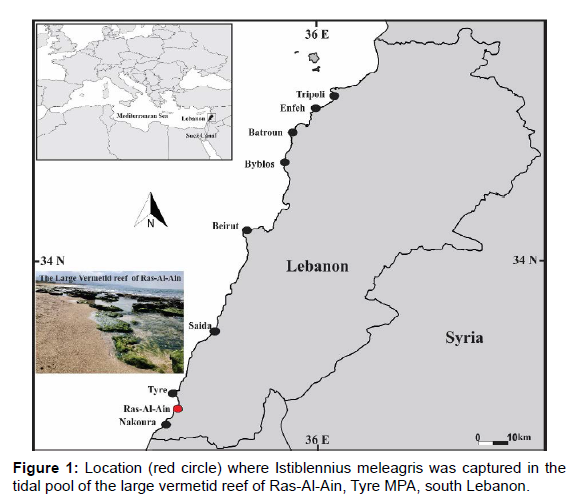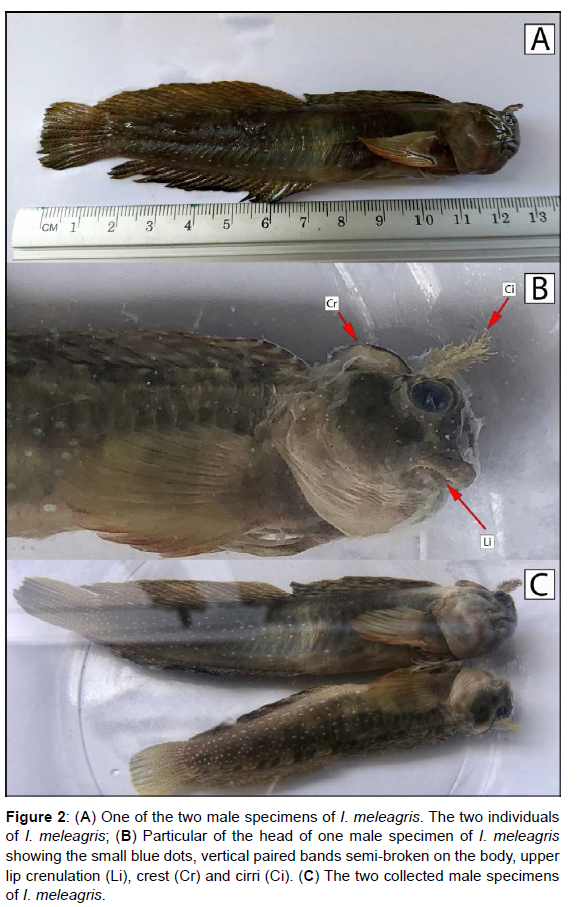The Expansion of the Peacock Rock Skipper Istiblennius meleagris (Valenciennes, 1836) in the Eastern Mediterranean Sea: First Record from the Lebanese Intertidal Reefs
Received: 01-Aug-2022 / Manuscript No. jflp-22-72541 / Editor assigned: 04-Aug-2022 / PreQC No. jflp-22-72541 (PQ) / Reviewed: 17-Aug-2022 / QC No. jflp-22- 72541 / Revised: 22-Aug-2022 / Manuscript No. jflp-22-72541 (R) / Published Date: 29-Aug-2022 DOI: 10.4172/2332-2608.1000362
Short Communication
The peacock rock skipper, Istiblennius meleagris [1], is a fish of the family Blenniidae. Fishes of this family are commonly known as comb tooth blennies and consist of about 400 species [2]. In the Mediterranean Sea, the family Blenniidae consists of 25 species, plus 2 freshwater species: Salaria economidisi Kottelat, 2004 and Salaria fluviatilis. A total of 5 out of the 25 marine species are reported as non-indigenous, namely: Istiblennius meleagris [1], Omobranchus punctatus [1], Ophioblennius atlanticus [1], Parablennius thysanius and Petroscirtes ancylodon Rüppell, 1835 [3, 4]. These species are generally common on rocky bottom in shallow waters, and some of them are common in the intertidal zone [5, 6]. Istiblennius meleagris is an endemic species for the Australian coast, from Queensland to Western Australia [7, 8]. In the Mediterranean Sea, I. meleagris was recently recorded for the first time from the Southern Levantine Sea by [9]. The species was observed in the years 2016 (a single individual), 2018 (a single individual) and 2019 (several individuals). No other records were reported thereafter.
A total of 18 species belonging to the family Blenniidae were recorded on the Lebanese coast, and only one is a Non-Indigenous Species (NIS), namely Petroscirtes ancylodon Rüppell, 1835 [10] . In this work, we report for the first time the presence of I. meleagris along the Lebanese coast. Therefore, this record constitutes the second one of the species from the Mediterranean waters.
On the 29th March 2022, two individuals of Istiblennius meleagris were observed and photographed from the tidal pools, at a depth of 1 m, of the large vermetid reef of the Marine Protected Area of Tyre (TCNR), south Lebanon (Figure 1) by one of us (AB). Subsequently, the two specimens were collected for analysis and identified following the morpho-chromatic and meristic characteristics reported by [4]. The two species were easily identified as male specimens by the presence of a well-developed laminar crest on the head. The specimens showed a total length of 95 and 125 mm. D: XII + 18–19; A: II + 20–21; P: 14 (Table 1). Body elongated, laterally compressed; a deep notch in the dorsal fin, thick and highly branched orbital cirrus, and crenulation of the upper lip. Beige to pale brown, to dark dusky-brown body color, covered by eight vertical semi-broken paired bands; numerous pale blue spots on the body and head. The description of the two collected specimens from the Lebanese waters perfectly matches to that reported by [4]. The specimens are currently preserved in the Institute of the Marine Protected Area of Tyre (TCNR), with code LEBNFIS1 and LEBNFIS2.
| Morphometric measurements (in mm) | ||
|---|---|---|
| Specimen 1 | Specimen 2 | |
| Total length | 95 | 125 |
| Standard length | 79 | 100 |
| Head length | 12 | 12 |
| Pre-anal length | 40 | 50 |
| Maximum height | 27 | 33 |
| Eye diameter | 3 | 4 |
| Meristics | ||
| Dorsal fin spines | 12 | 12 |
| Dorsal fin rays | 18 | 19 |
| Pectoral fin rays | 14 | 14 |
| Anal fin spines | 2 | 2 |
| Anal fin rays | 20 | 21 |
| Caudal fin rays | 13 | 13 |
Table 1: Meristic and morphometric characters of I. meleagris (male) collected along the Mediterranean coast of Lebanon.
This record of I. meleagris constitutes the second observation of the species in the Mediterranean Sea, and the first from Lebanon. This record supports the hypothesis that such species, probably initially introduced in the Mediterranean Sea through ballast waters, is expanding its range in the basin starting from the already population established in the Southern Levantine Sea. I. meleagris could be an invasive species worth of particular attention for the scientific community (Figure 2). In this regard, citizen science project could be a useful and low cost tool to monitoring any further spreading of the species in the Mediterranean Sea [11]. A similar trend and the same introduction and expansion ways were also suggested for the Atlantic blenny Ophioblennius atlanticus [1], recently reported in several locations of the central Mediterranean Sea [12,13].
Figure 2: (A) One of the two male specimens of I. meleagris. The two individuals of I. meleagris; (B) Particular of the head of one male specimen of I. meleagris showing the small blue dots, vertical paired bands semi-broken on the body, upper lip crenulation (Li), crest (Cr) and cirri (Ci). (C) The two collected male specimens of I. meleagris.
Istiblennius meleagris inhabits the intertidal reefs, as also showed by our study. Indeed, our specimens were observed and collected from the tidal pool of the vermetid reef of Tyre. Furthermore, it seems that I. meleagris appeared to be bold and aggressive towards native species, such as Parablennius sanguinolentus and Salaria pavo, two species usually common in tidal pool systems. Therefore, further investigations are required to elucidate the effect of this new NIS on local ecosystems and native species.
Based on the fact that blennies and gobies are among the most common fish species being transported and introduced via shipping globally [7], and several NIS have been introduced to the western and eastern Mediterranean via shipping [12, 4] , special attention should be paid to these small cryptobenthic fishes and their presence in strategic areas such as big harbors. From a conservation point of view, it is important to update the checklist of non-indigenous species along the Lebanese coast, and in little studied areas in general, through targeted and periodic monitoring programs. We also highlight the need to establish an efficient monitoring program targeting the most invasive NIS that have already established along the Lebanese coasts. This step will help understand the status and effects of these species and to adopt some measures to reduce the impacts on the local communities and habitats.
References
- Fricke R, Eschmeyer WN, Fong JD (2021) Eschemeyer’s Catalog of Fishes. Genera/species by family/subfamily.
- Tiralongo F (2020) Blennies of the Mediterranean Sea: Biology and identification of Blenniidae, Clinidae, Tripterygiidae. Amazon Distribution, Leipzig, Germany, 131 pp.
- Rothman, Shevy, Kfir Gayer, Nir Stern (2020) "A long-distance traveler: the peacock rock skipper Istiblennius meleagris (Valenciennes, 1836) on the Mediterranean intertidal reefs". Biol Invasions 22: 2401-2408.
- Tiralongo F, Tibullo D, Brundo MV, De Mendoza Paladini F, Melchiorri C et al (2016) Habitat preference of comb tooth blennies (Actinopterygii: Perciformes: Blenniidae) in very shallow waters of the Ionian Sea, south-eastern Sicily, Italy. Acta Ichthyol Piscat 46: 65–75.
- Froese, Rainer, Pauly, Daniel (2013) "Istiblennius meleagris" in Fish Base. February 2013 version.
- Williams JT, Rob Myers (2014) "Istiblennius meleagris". IUCN Red List of Threatened Species. 2014: e.T48342442A48388872.
- Bitar G, Badreddine A (2021) The marine ichthyofauna of Lebanon: an annotated checklist, history, biogeography, and conservation status. Zoo taxa 5010: 001–128.
- Tiralongo F, Lillo AO, Tibullo D, Tondo E, Macali A (2019) Monitoring uncommon and non-indigenous fishes in Italian waters: One year of results for the Alien Fish project. Reg Stud Mar Sci 28: 100606-100608.
- Azzurro E, Zannaki C, Andaloro F, Giardina F, Tiralongo F (2018) First record of Ophioblennius atlanticus (Valenciennes, 1836) in Italian waters, with considerations on effective NIS monitoring in Mediterranean marine protected areas. Bio Invasions Rec 7:437–440
- Tiralongo F, Azzurro E (2020) First record of the red lip blenny, Ophioblennius atlanticus (Valenciennes, 1836), from the Ionian Sea. In: Ragkousis et al. 2020. New Alien Mediterranean Biodiversity Records. Mediterr Mar Sci 21: 631–652.
- Wonham MJ, Carlton JT, Ruiz GM, Smith LD (2000) Fish and ships: relating dispersal frequency to success in biological invasions. Mar Biol 136:1111–1121
Indexed at, Google Scholar, Crossref
Indexed at, Google Scholar, Crossref
Indexed at, Google Scholar, Crossref
Citation: Badreddine A, Tiralongo SF (2022) The Expansion of the Peacock Rock Skipper Istiblennius meleagris (Valenciennes, 1836) in the Eastern Mediterranean Sea: First Record from the Lebanese Intertidal Reefs. J Fisheries Livest Prod 10: 362. DOI: 10.4172/2332-2608.1000362
Copyright: © 2022 Badreddine A, et al. This is an open-access article distributed under the terms of the Creative Commons Attribution License, which permits unrestricted use, distribution, and reproduction in any medium, provided the original author and source are credited.


